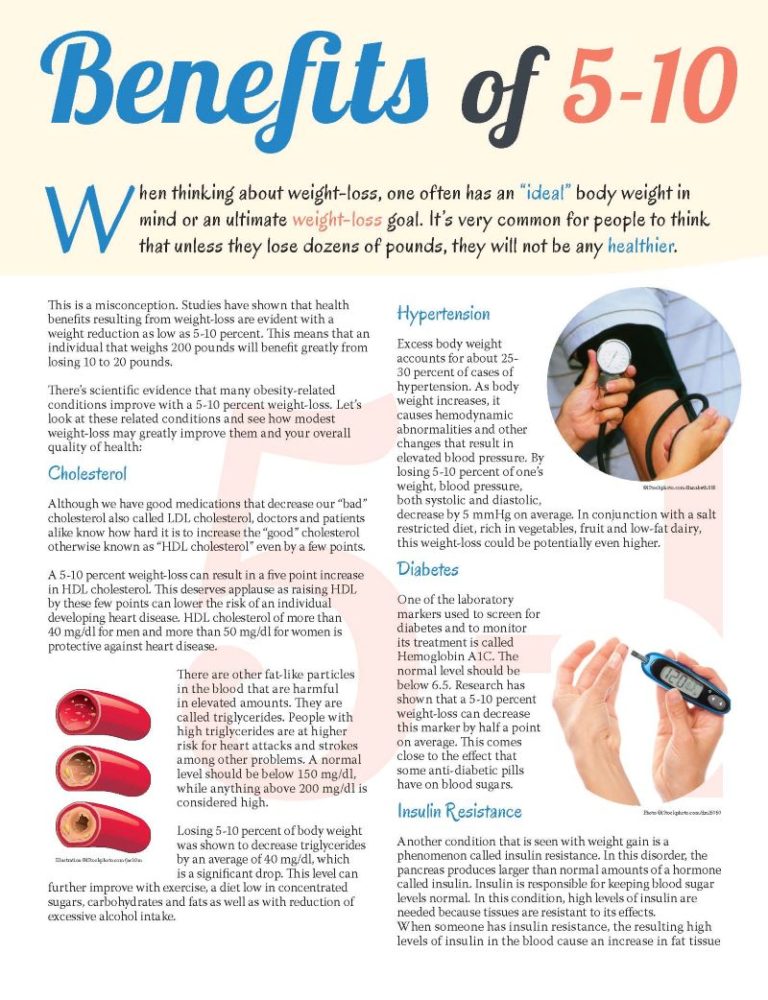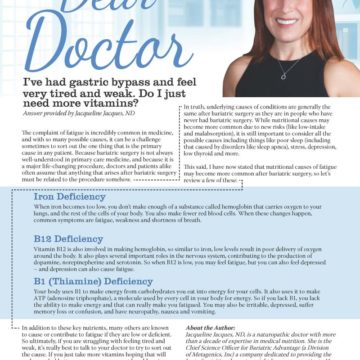Benefits of 5-10 Percent Weight-loss


by Nadia B. Pietrzykowska, MD, FACP
Fall 2013
When thinking about weight-loss, one often has an “ideal” body weight in mind or an ultimate weight-loss goal. It’s very common for people to think that unless they lose dozens of pounds, they will not be any healthier.
This is a misconception. Studies have shown that health benefits resulting from weight-loss are evident with a weight reduction as low as 5-10 percent. This means that an individual that weighs 200 pounds will benefit greatly from losing 10 to 20 pounds.
There’s scientific evidence that many obesity-related conditions improve with a 5-10 percent weight-loss. Let’s look at these related conditions and see how modest weight-loss may greatly improve them and your overall quality of health:
Cholesterol
Although we have good medications that decrease our “bad” cholesterol also called LDL cholesterol, doctors and patients alike know how hard it is to increase the “good” cholesterol otherwise known as “HDL cholesterol” even by a few points.
A 5-10 percent weight-loss can result in a five point increase in HDL cholesterol. This deserves applause as raising HDL by these few points can lower the risk of an individual developing heart disease. HDL cholesterol of more than 40 mg/dl for men and more than 50 mg/dl for women is protective against heart disease.
There are other fat-like particles in the blood that are harmful in elevated amounts. They are called triglycerides. People with high triglycerides are at higher risk for heart attacks and strokes among other problems. A normal level should be below 150 mg/dl, while anything above 200 mg/dl is considered high.
Losing 5-10 percent of body weight was shown to decrease triglycerides by an average of 40 mg/dl, which is a significant drop. This level can further improve with exercise, a diet low in concentrated sugars, carbohydrates and fats as well as with reduction of excessive alcohol intake.
Hypertension
Excess body weight accounts for about 25-30 percent of cases of hypertension. As body weight increases, it causes hemodynamic abnormalities and other changes that result in elevated blood pressure. By losing 5-10 percent of one’s weight, blood pressure, both systolic and diastolic, decrease by 5 mmHg on average. In conjunction with a salt restricted diet, rich in vegetables, fruit and low-fat dairy, this weight-loss could be potentially even higher.
Diabetes
One of the laboratory markers used to screen for diabetes and to monitor its treatment is called Hemoglobin A1C. The normal level should be below 6.5. Research has shown that a 5-10 percent weight-loss can decrease this marker by half a point on average. This comes close to the effect that some anti-diabetic pills have on blood sugars.
Insulin Resistance
Another condition that is seen with weight gain is a phenomenon called insulin resistance. In this disorder, the pancreas produces larger than normal amounts of a hormone called insulin. Insulin is responsible for keeping blood sugar levels normal. In this condition, high levels of insulin are needed because tissues are resistant to its effects.
When someone has insulin resistance, the resulting high levels of insulin in the blood cause an increase in fat tissue especially in the waist area, abnormal cholesterol, and sometimes a change in certain hormone levels in women that causes male pattern hair growth and infertility. Modest weight-loss was found to significantly decrease insulin levels and thus to help with reversing these conditions.
Obstructive Sleep Apnea
Obstructive sleep apnea is a sleep disorder commonly diagnosed in patients affected by excess weight that snore or gasp for air during sleep. It’s caused by pauses and gaps in breathing during sleep and results in insufficient oxygenation. This causes fatigue and sleepiness during the day. It also is responsible for making certain diseases less responsive to treatment, like hypertension for example.
When sleep apnea is significant, oxygen levels in the blood are too low during sleep and the use of a breathing machine called CPAP is necessary. It has been shown that a 5-10 percent weight-loss may improve sleep apnea and sometimes if the apnea was not very severe, one can be weaned from the CPAP breathing machine. This is a big achievement for some, as having to use a CPAP is life-saving but often perceived as cumbersome by those who need to use it.
Inflammation
In studies looking at the effect of excess weight on cells of the human body, it was found that fat cells and especially abdominal fat cells produce a large number of substances that result in inflammation in blood vessels. This inflammation then can result in plaques and clots and turn into strokes and heart attacks. When weight-loss achieves a level of 10 percent, the levels of inflammatory substances circulating in the blood drop significantly and therefore the risk of vascular damage is reduced as well.
Conclusion
All these improvements caused by weight-loss as low as 5-10 percent ultimately lead to very significant benefits including a lesser chance of having a heart attack or stroke. Now, the next question that comes to mind is since we know that a 5-10 percent weight-loss is very beneficial, how can it be achieved?
First and foremost, weight-loss starts with lifestyle changes: diet and exercise. The first step is to talk to your healthcare provider. They will help choose the diet that is most appropriate. The diet choices are usually determined by the existing medical problems among other factors and should be discussed with your healthcare provider. On this note, it is worth mentioning that scientists have recently shown that a “Mediterranean diet,” which is rich in fish, vegetables, olive oil or nuts will protect you from heart disease even more when compared to other commonly used diets.
To attain and maintain any amount of weight-loss, exercise is mandatory. Generally, an average of at least one hour, five days a week is needed. But this again should be monitored by your healthcare provider to assure safe exercise practices.
Scientists have shown over and over again that lifestyle changes that include an appropriate healthy diet and the right exercise regimen will help attain a 5-10 percent weight-loss. In addition, any legitimate weight-loss program should promote these lifestyle changes as the first step in attaining weight-loss. They are absolutely indispensable. They work on their own when the planned weight-loss is 5-10 percent of body weight and are always used in conjunction with other measures (weight-loss medications or bariatric surgery) if a more significant weight-loss is needed or when lifestyle changes by themselves did not achieve the medically required weight-loss goal.
Thus, when contemplating weight-loss, the initial goal may be set as low as 5-10 percent of body weight. As discussed in this article, this seemingly modest weight change already results in tremendous health benefits.
About the Author:
Nadia B. Pietrzykowska, MD, FACP, is a Board Certified Physician Nutrition Specialist with Residency training in Internal medicine and subspecialty training in Bariatric Medicine and Nutrition.
by Yelena Kibasova Spring 2024 The fitness world is evolving, with new trends and innovations that promise…
Read Articleby Zack Lucks, NASM-CPT, EMT Winter 2024 Working out with a loved one is a great way…
Read Articleby Nina Crowley, PhD, RD (with Inspiration from Shawn Cochran) Winter 2024 Dating, no matter your age,…
Read Article








